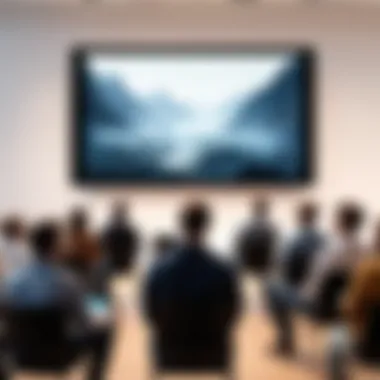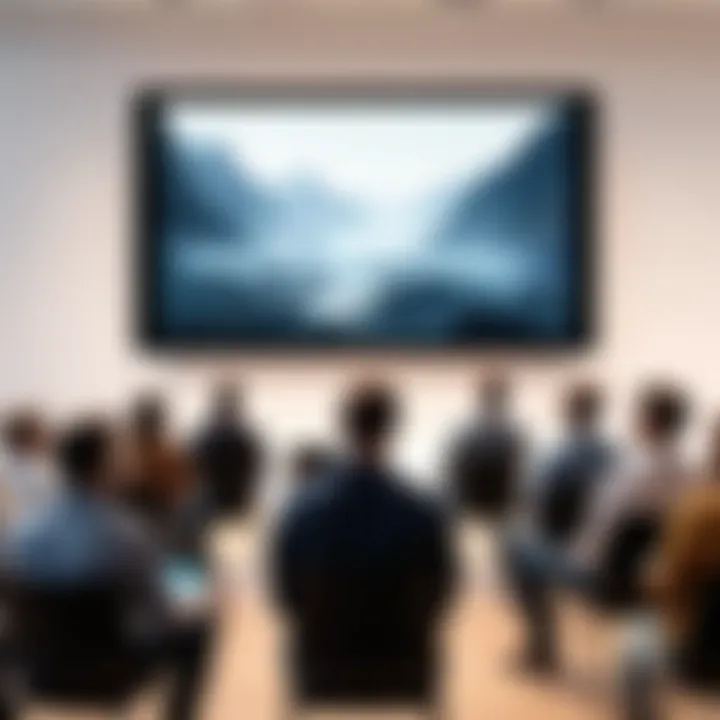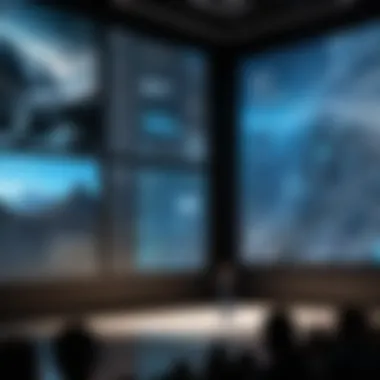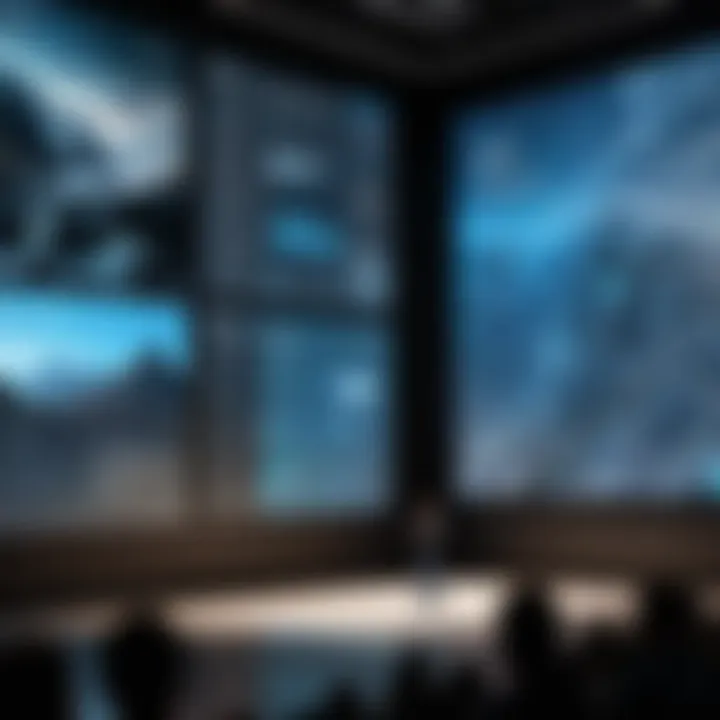Exploring the Significance of Artist Talks in Art


Intro
Artist talks have emerged as a key component in the contemporary art scene. These events offer a platform for artists to share their thoughts, motivations, and processes directly with audiences. Understanding why these conversations matter requires a look at their various formats and contexts. From formal lectures to informal discussions, the nature of these talks varies significantly, often influenced by the evolving cultural landscape.
In today's world, audience engagement is more critical than ever. Artists and institutions must navigate complex dynamics to foster meaningful connections. By examining the intricate motivations behind artist talks, we not only uncover the artists' intent but also reflect on how these discussions shape public perception of art.
Considerably, the impact extends beyond just the participants. Audience members can gain unique insights into the artistic process and the societal context surrounding the artwork, fostering a deeper appreciation and understanding.
This article will delve into several essential aspects:
- The significance of outreach and public engagement strategies in fostering connections.
- The diverse formats that artist talks can take, from studio visits to digital webinars.
- The influence of technology and how it is reshaping conversations about art.
- The potential effects on both artists and audiences within the contemporary discourse.
Through this exploration, we aim to provide a nuanced perspective on the vital role artist talks play in enriching cultural dialogue in today’s society.
Understanding Artist Talks
Artist talks play a crucial role in the contemporary art landscape. They offer insights into the minds of the artists, bridging the gap between the creator and the audience. Understanding artist talks involves recognizing their essential function, the context in which they occur, and how they influence artistic practice. These discussions can deepen appreciation for artworks and enable dialogue and interaction. The importance lies not only in the content of the talks but also in how they facilitate connections among various stakeholders in the art community.
Definition and Purpose
Artist talks are structured dialogues where artists present their work, methods, and ideas to an audience. These events can take various forms, such as lectures, discussions, or informal Q&A sessions. Their purpose extends beyond mere exhibition of art. They aim to humanize the artistic process, demystifying the barriers between artists and the public. By providing a platform for artists to share their narratives, these talks foster engagement, prompting audiences to think critically about the art presented.
Historical Context
The concept of artist talks is not new. Historically, artistic expression has often involved commentary and discussion. In the 20th century, with the rise of modernism, artist talks became more formalized. Institutions like galleries and museums started hosting these events to promote interaction. The post-war period saw a significant expansion in public discussions around art. This context reflects changing attitudes towards art, from viewing it solely as a product to recognizing it as a conversation starter within society.
The Role in Artistic Practice
Artist talks are pivotal in shaping artistic practice. They provide a space for reflection and critique, allowing artists to articulate their philosophies and methodologies. Through these discussions, artists can receive feedback, gain new perspectives, and even refine their work based on audience interaction. This dynamic engagement contributes to their growth, challenging them to consider how their art is perceived. Furthermore, artist talks promote collaboration and networking, which are essential in the art world.
"Artist talks are essential not just for sharing ideas, but for building a community around art and fostering ongoing conversations."
In summary, understanding artist talks involves looking at their definition, historical significance, and their vital role in contemporary artistic practice. They serve as a channel for communication that strengthens the relationship between artists and audiences.
Key Components of Artist Talks
Artist talks serve as a critical intersection of shared knowledge between artists, curators, and the audience. Understanding the key components of these discussions helps clarify their diverse nature and significance. Essential elements such as the participants involved, the facilitation of the talk, and audience interaction are pivotal. Each component plays a unique role in enhancing engagement and fostering deeper connections within the art community.
Who Participates?
Artists
Artists are often at the forefront of artist talks. Their ability to share personal narratives enriches the discourse, giving context to their work. The key characteristic of artists is their creative vision, which provides insightful perspectives. This role is not only beneficial for the audience; it also allows artists to articulate their motivations. An advantage of involving artists is that their authenticity can foster a genuine connection with attendees. However, there can be disadvantages. Some artists may struggle to communicate their concepts effectively, which could lead to misunderstandings.
Curators


Curators also play a vital role in artist talks. They offer a curated viewpoint and provide context that frames the artists' work within broader themes or movements. The key characteristic of curators is their expertise in art history and trends, making them a valuable resource for deepening discussions. Curators help shape the narrative around artworks, drawing connections that might not be immediately obvious. One unique feature of curators is their skill in engaging the audience, which can enhance the overall experience. Nevertheless, sometimes the curator's perspective may overshadow the artist's voice, which can dilute the authenticity of the dialogue.
Audience Members
An artist talk is incomplete without its audience. Audience members bring diverse backgrounds and interpretations, which can enrich the conversation. Their key characteristic is their varied engagement levels, ranging from art enthusiasts to laypersons. This diversity is a beneficial aspect, as it encourages open discussions and innovation. Audience members often ask thought-provoking questions that can lead to surprising insights. However, a notable disadvantage is that if the audience is not well-versed in the subject, discussions might lack depth, limiting the value of the exchange.
Facilitation and Moderation
Effective facilitation and moderation are crucial for successful artist talks. A good moderator navigates the conversation, ensuring all voices are heard, and maintaining a balance between discussion and audience interaction. This role can guide the conversation and keep it focused on meaningful themes. A skilled facilitator can make or break the experience, so their involvement is key in creating a respectful and engaging environment.
Audience Interaction
Audience interaction significantly impacts the dynamics of artist talks. Engaging an audience can take many forms, including Q&A sessions, live feedback, or digital polls. This interaction not only fosters a sense of community but also allows attendees to feel invested in the conversation. It is critical for the audience to feel their contributions are valued. While successful interaction can enhance the experience, poorly managed audience engagement may lead to confusion or disengagement, limiting the effectiveness of the talk.
"Artist talks should engage audiences, allowing for a symbiotic relationship between the speaker and listener, fostering a richer dialogue around contemporary art."
Understanding the key components of artist talks enhances our appreciation for these events, spotlighting their importance in today’s cultural landscape.
Formats and Settings
In the realm of artist talks, the formats and settings significantly influence the experience of both the speakers and the audience. These aspects determine not only the dynamics of the presentation but also the interaction level and overall impact of the discourse. Understanding the different formats is crucial for maximizing engagement and fostering meaningful conversations.
In-Person vs. Virtual Events
The choice between in-person and virtual events reflects various practical considerations. In-person events provide a unique energy that enhances conversations; faces can be seen, expressions can be read, and immediate feedback is possible. Such interactions foster a community atmosphere that often deepens the audience's connection to the discussed artwork or concepts.
On the other hand, virtual events bring flexibility and accessibility to a broader audience. They reduce geographical barriers and allow participation from individuals who may have logistical challenges attending physically. However, virtual formats might lack the personal touch inherent in face-to-face gatherings. Audio and video quality becomes essential in virtual settings, often determining engagement levels. It is important to evaluate the context and purpose of the artist talk when choosing the format.
Panel Discussions
Panel discussions can be especially enriching as they allow multiple voices to contribute to a single conversation. This format encourages diverse perspectives and promotes a more comprehensive exploration of the topic at hand. In a panel discussion, selected artists or experts can engage with each other, while the audience gets insight into diverse viewpoints.
One benefit of this format is that it can stimulate thought-provoking dialog. Audiences often appreciate the interplay of ideas between different panelists. Structuring the discussion through key questions can lead to deeper insights. Attention should be paid to the selection of panelists to ensure a balanced representation of viewpoints, which enhances the overall discourse.
Workshops and Hands-On Sessions
Workshop formats invite active participation from audience members, transforming spectators into contributors. Here, learning and exploration are central. These sessions are designed to be interactive, allowing participants to engage directly with an artist's techniques or concepts. This hands-on approach often fosters a more profound understanding and emotional connection to the subject matter.
It is vital to consider audience skill levels when crafting workshops. Tailored sessions can cater to different experience levels, enabling a wider range of participants. Additionally, the setting for workshops must support collaboration and create an open atmosphere for sharing ideas and techniques. By blending instructional methods with personal expression, workshops not only enhance artistic skills but also cement community ties among participants.
The formats and settings of artist talks significantly shape the interaction quality, determine audience engagement levels, and impact the overall effectiveness of the dialogue that follows.
In summary, the formats and settings chosen for artist talks play a pivotal role in shaping the audience experience. Each has unique advantages and challenges that should be carefully considered based on the goals of the talk and the needs of the audience.
Impact on Artists


Artist talks hold significant influence over the professional trajectory of artists. They serve as a platform where artists can articulate their thoughts, share their creative processes, and explain the context behind their work. This interaction provides not only visibility but also an avenue for dialogue that enriches artistic practice.
Career Development
Career development through artist talks is multifaceted. These events offer artists a chance to build their professional profiles. Speaking engagements allow them to showcase their skills and expertise, capturing the attention of galleries, curators, and collectors.
Furthermore, artist talks can lead to opportunities for exhibitions and partnerships. When artists effectively communicate their vision and practice, they often become memorable figures in the contemporary art landscape. This visibility can result in invitations to participate in group exhibitions, contributing to career advancement.
In addition, talks can act as a form of mentorship. Emerging artists can learn from established professionals, gaining insights that may not be readily available through traditional education. The shared knowledge during these talks aids in navigating complex art networks.
Networking Opportunities
Networking is another vital component of artist talks. They attract diverse audiences, including other artists, critics, and art enthusiasts. The informal nature of interaction before or after a talk fosters connections that may not have been possible otherwise.
For instance, an artist may meet a curator interested in their portfolio. Similarly, discussions among peers may lead to collaborations or joint projects. These connections often extend far beyond the event itself, creating a web of relationships that can significantly influence an artist's career.
Engaging with audience members can also enhance an artist's understanding of public reception. This connection can inform their future work and presentation of art, allowing for a more tailored approach to their practice.
Public Perception and Branding
Public perception plays a crucial role in the branding of an artist. Artist talks are vital in shaping how the public views their work. Well-articulated talks can enhance an artist's reputation and help cultivate a distinct brand identity.
When artists effectively communicate their unique perspectives, they become more relatable to audiences. This connection can transform casual viewers into dedicated supporters.
Moreover, frequent participation in artist talks may establish an artist as a thought leader in a specific niche. This authority can lead to greater respect within the art community and audience. Building a cohesive online presence is also crucial; sharing recordings of talks on platforms like Facebook can further elevate visibility.
"Artist talks provide an essential platform for dialogue that enriches both artistic practice and public engagement."
Audience Engagement and Outreach
Artist talks present a unique opportunity for engagement and outreach, both for artists and their audiences. The effectiveness of these talks often hinges on how well they connect with the intended audience. Engaging an audience creates a dialogue that transcends beyond the conventional exhibition experience, fostering personal connections and a deeper understanding of the artwork. This section explores the mechanisms of audience engagement, including understanding demographics, outreach strategies, and the importance of feedback.
Understanding Audience Demographics
One of the most crucial steps in audience engagement is understanding the demographics of the attendees. Knowledge of age, cultural background, and art-related experience can greatly influence the content and format of talks. For instance, a younger crowd might prefer contemporary issues and digital art, while an older audience might appreciate historical contexts and traditional mediums. By identifying these parameters, artists and facilitators can tailor their language, visual aids, and overall narrative to enhance relatability and comprehension.
Strategies for Effective Outreach
The outreach strategy encompasses various tactics designed to attract the right audience to artist talks. Comprehensive planning can include:
- Social Media Marketing: Platforms like Facebook and Instagram can be instrumental in promoting events. Engaging posts and targeted ads can reach specific audience segments.
- Community Engagement Initiatives: Collaborating with local organizations can broaden the audience base and create a shared interest in the artistic dialogue. Partnerships with schools, non-profits, and cultural institutions can yield reciprocal benefits.
- Email Campaigns: Regular newsletters featuring upcoming talks can keep interested individuals informed and engaged. Personalization of outreach materials can further enhance effectiveness.
Effectively engaging an audience not only extends the reach of artist talks but also enriches the experience for all involved.
Feedback and Discussion


Collecting and analyzing feedback post-event is vital for continuous improvement. Open forums or structured surveys can facilitate audience response, allowing facilitators to gauge the success of their methods and content. This feedback also provides valuable insights into the audience's interests for future events. Here is how to effectively implement feedback:
- Surveys: Distributing quick surveys at the end or shortly after the talks can yield immediate thoughts on their experience.
- Follow-Up Discussions: Hosting informal meet-ups after an event encourages continued dialogue and relationship building with the audience.
- Social Media Engagement: Encouraging attendees to share their thoughts and experiences on social media platforms can create a broader discussion and attract new audiences.
Challenges in Artist Talks
Artist talks play a significant role in bridging the gap between artists and their audiences. However, the dynamics surrounding these conversations are not free from obstacles. It is crucial to recognize these challenges as they not only affect the quality of dialogue but also shape the overall impact of these events. This section examines three central issues: technological barriers, accessibility concerns, and the need for cultural sensitivity and inclusivity.
Technological Barriers
In the digital age, technology is both a facilitator and a hindrance for artist talks. Virtual platforms allow for wider access and interaction but introduce several complications. First, a reliable internet connection is essential. If speakers or attendees face connectivity issues, the flow of conversation can be disrupted.
Moreover, different software presents various user experiences. Some may be intuitive, while others require technical knowledge. This disparity can alienate less tech-savvy individuals from participating actively. It’s essential to choose the right platform that accommodates all users, ensuring a seamless experience.
Furthermore, recorded sessions often miss the essence of live interaction, sacrificing spontaneity for convenience. The challenge lies in maintaining the authenticity of discussions amidst the constraints of technology.
Accessibility Issues
Accessibility is another crucial aspect of artist talks that must not be overlooked. Events should aim to be inclusive to individuals of varied abilities, backgrounds, and experiences. Physical spaces must be equipped with ramps, appropriate seating, and audio-visual aids. When events are held online, captions and transcripts become essential. Such features enhance participation for individuals with hearing impairments.
Critically, promoting awareness about these accessibility measures is necessary. Organizers need to communicate clearly what accommodations are available, ensuring that all potential attendees feel welcomed. A lack of information may discourage attendance and perpetuate exclusivity.
Cultural Sensitivity and Inclusivity
Cultural sensitivity is pivotal in shaping artist talks that resonate with diverse audiences. Discussions that fail to consider cultural contexts can result in misunderstandings or even offense. It is crucial for organizers to include voices from various cultural backgrounds. Diverse panels not only enrich conversations but also foster a sense of belonging for all attendees.
Moreover, fostering an inclusive environment means ensuring all attendees feel safe to express their thoughts. Moderators play a crucial role here; they must guide discussions effectively, so sensitive topics are handled with care. By prioritizing inclusivity at artist talks, organizers can create spaces that celebrate diversity and promote understanding.
"A successful artist talk is one that transcends barriers, creating an environment where every voice is heard, and every story matters."
The Future of Artist Talks
The future of artist talks holds significant implications for how we engage with art and artists in a rapidly changing world. As technology continues to reshape the landscape, the ways in which these discussions take place are evolving. There are several elements that are crucial to understanding this future. These elements include emerging trends, the role social media plays, and the growing popularity of hybrid models for engagement. Each element contributes to a broader framework that embraces both artists and audiences alike, offering insights and developing dialogues that can enhance artistic practices.
Emerging Trends
In recent years, several trends have surfaced in the realm of artist talks. One prominent trend is the incorporation of technology into these discussions. Artists can now present their works through augmented reality or virtual exhibitions, which allow audiences a more immersive experience. These formats not only engage viewers but also invite them to participate in the conversation.
Additionally, there is a heightened emphasis on interdisciplinary collaborations. Artists are engaging with experts from various fields, such as science, technology, and social issues. This cross-pollination expands the themes discussed and encourages a more holistic understanding of the art itself. The prevalence of mobile platforms also allows for real-time conversations and feedback, making artist talks more dynamic and immediate.
"The importance of technology in art discussions cannot be understated—it opens new avenues of experience that were previously impossible."
The Role of Social Media
Social media has revolutionized how artist talks are publicized and executed. Platforms like Facebook and Instagram allow artists to reach broader audiences. Post-event discussions can thrive on these platforms, enabling ongoing engagement beyond the physical venue.
Moreover, social media facilitates real-time interaction during the talk itself. Audiences can comment, ask questions, and share their thoughts instantly. This immediacy can enhance the experience for both artists and attendees, creating an inclusive atmosphere. Additionally, content recorded during artist talks can be shared widely, creating valuable archival material and increasing an artist's visibility.
Hybrid Models of Engagement
Hybrid models are becoming increasingly popular within the context of artist talks. These formats combine physical presence with virtual participation, allowing flexibility for audiences. For example, an in-person talk may also be streamed live, reaching participants who cannot attend physically, whether due to distance or accessibility issues.
This model not only expands the audience base but also generates additional resources through potential ticket sales and sponsorship opportunities. Hybrid events can cater to multiple time zones, thus increasing global participation. An effective hybrid format ensures that the essence of the discussion is preserved, whether attendees are physically present or participating online.







